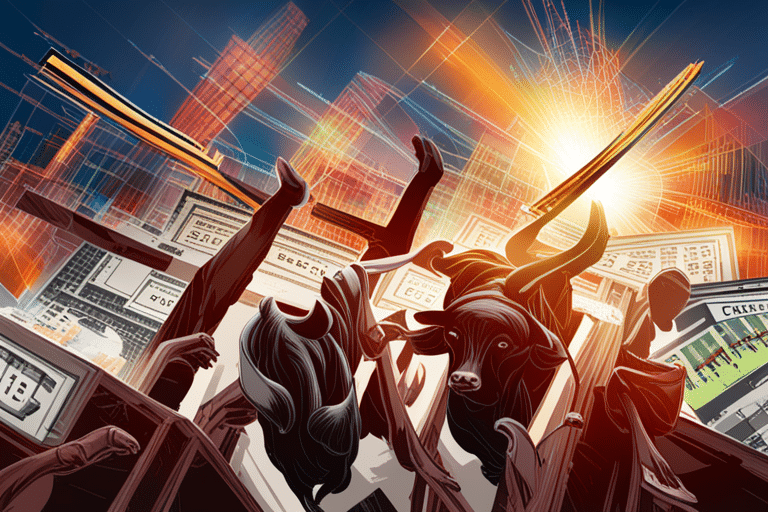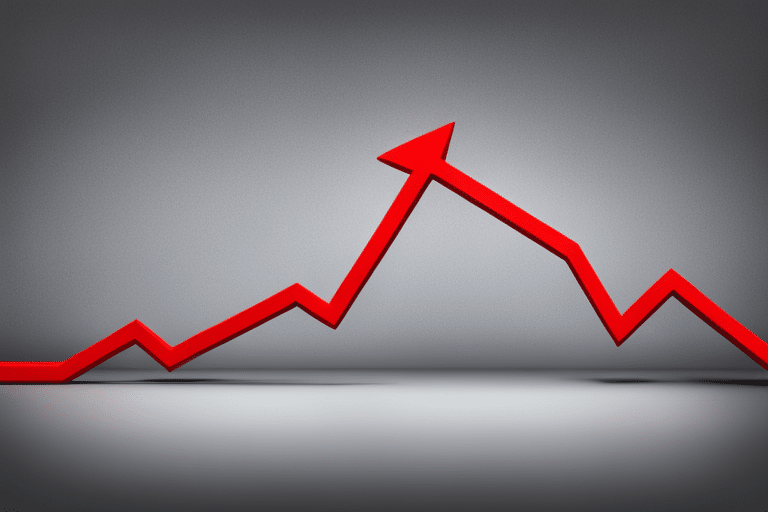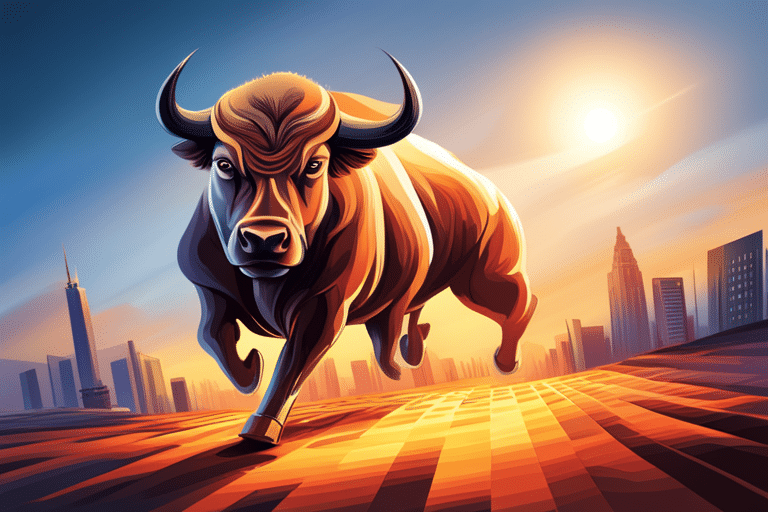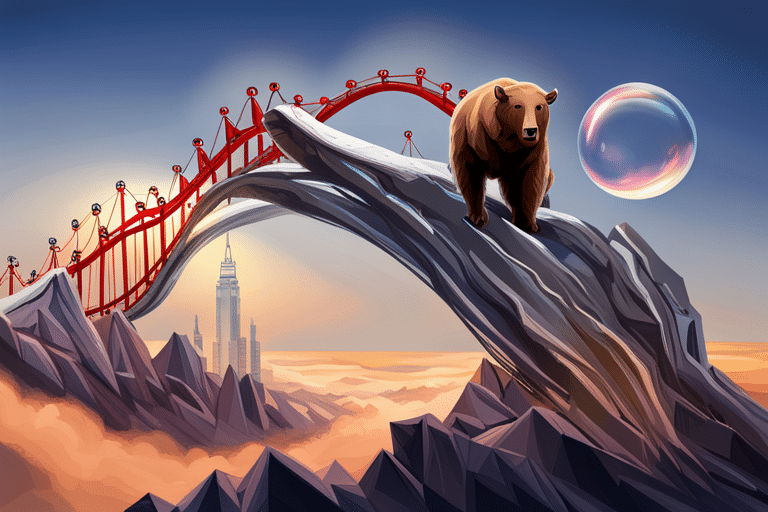Imagine you’re a fearless adventurer, navigating the treacherous terrain of the stock market. Like a skilled mountaineer, you need to understand the peaks and valleys of bull markets, bear markets, and bubbles.
In this wild journey called investing, it’s crucial to grasp the cycles that shape the stock market. So strap on your boots and let’s explore how these forces affect your financial landscape.
Get ready for an exhilarating ride through Bull Markets, Bear Markets, and Bubbles: Understanding Stock Market Cycles!
Key Takeaways
- Bull markets are characterized by rising stock prices, optimistic investor sentiment, and positive economic data.
- Bear markets are marked by market downturns, declining stock prices, and investor panic and fear.
- Investor sentiment during market downturns can be influenced by fear, anxiety, and uncertainty.
- Bubbles in the stock market can cause chaos and instability, with key warning signs including rapid price increases, excessive optimism, and irrational behavior.
The Basics of Bull Markets

You’re probably wondering, what exactly is a bull market and how does it work? Well, my curious friend, let me enlighten you on the whimsical world of stock market upturns.
A bull market is like a carnival ride that takes investors on an exhilarating journey of rising stock prices and soaring profits. It’s a time when optimism fills the air and everyone wants to jump on the bandwagon.
So how do you know if you’re in a bull market? There are some key indicators to look out for. First, there’s the roaring enthusiasm of investors who can’t stop talking about their gains. Then, there’s the steady climb of stock prices, as if they were magical mountains reaching for the sky. And let’s not forget about the positive economic data that paints a picture of prosperity and growth.
Investing during a bull market can be quite profitable if done wisely. It’s like being at a fair where every game seems winnable and every prize within reach. But remember, my friend, with great excitement comes great risk. Bull markets don’t last forever, just like cotton candy melts in your mouth. So it’s important to keep an eye out for signs that this wild ride might be coming to an end.
Now that we’ve explored the joyous world of bull markets, let’s move on to darker territory – bear markets. These are times when stocks go into hibernation mode and take investors along for a bumpy ride downhill. But fear not! We’ll delve into those characteristics later on in our exploration of stock market cycles.
The Characteristics of Bear Markets

Ah, bear markets! Those pesky creatures that send investors running for the hills. But have you ever wondered what causes these market downturns?
Well, my friend, it could be anything from economic recessions to geopolitical tensions to good old-fashioned panic and fear. And let me tell you, when a bear market strikes, investor sentiment takes a nosedive faster than a roller coaster on steroids.
Suddenly, everyone’s selling their stocks and hoarding cash like it’s going out of style. So buckle up and prepare for a wild ride as we explore the causes of bear markets and how they impact our oh-so-fragile investor emotions.
Causes of Bear Markets
When it comes to bear markets, understanding the causes is crucial for investors like yourself. So, grab your thinking cap and let’s dive into the wild world of market downturns!
Here are three factors that can cause a bear market:
-
Economic Factors: Ah, the wonders of economics! Things like recessions, high unemployment rates, and inflation can send the stock market tumbling down faster than a roller coaster ride. It’s like trying to balance a stack of pancakes on a wobbly table – not an easy task!
-
Investor Behavior: We humans are quite the unpredictable bunch. Fear and panic can spread through the investing community faster than a rumor in high school. When investors start selling their stocks left and right, it creates a domino effect that brings prices crashing down.
-
Market Overvaluation: Picture this – everyone is hyped up about certain stocks and they start buying them like there’s no tomorrow. But when reality kicks in and those stocks don’t live up to expectations, well, let’s just say it’s like blowing up a balloon until it pops.
Impact on Investor Sentiment
Investor sentiment can be greatly influenced by the impact of market downturns. When the stock market takes a nosedive, it’s like a rollercoaster ride for your emotions. One moment, you’re on top of the world, and the next, you’re gripping onto your seat in fear. It’s all part of investor psychology and understanding how market speculation plays into our moods.
To truly grasp the impact on investor sentiment during market downturns, let’s take a peek at this whimsical table:
| Investor Psychology | Market Speculation |
|---|---|
| Fear | Uncertainty |
| Anxiety | Panic Selling |
| Greed | Shorting Stocks |
| Hope | Bottom Fishing |
| Patience | Rationalizing Loss |
As an investor, it’s important to recognize that our emotions can cloud our judgment. During times of uncertainty, it’s crucial to stay level-headed and resist the urge to make impulsive decisions based on fear or greed. Remember, mastering investor psychology is key to navigating through the ups and downs of the market with grace and confidence.
The Impact of Bubbles on Stock Market Cycles

Oh, bubbles! They’re so much fun to blow and pop, but in the stock market world, they can cause quite a commotion. When a bubble bursts, it’s like a balloon popping – there are consequences aplenty.
Market volatility during these bubbly times can make your head spin faster than a roller coaster ride. And let’s not forget about investor behavior – it’s truly fascinating how people react when their investments start floating away in the bubble-filled sky.
Bubble Burst Consequences
Be prepared for the consequences of a bubble burst, as it can have significant impacts on your investments and financial stability. Here are three things to keep in mind when facing the aftermath of a bursting bubble:
-
Economic Ripples: When a bubble bursts, it sends shockwaves through the economy like an ice cream headache after gulping down a milkshake too fast. The impact is felt far and wide, from job losses to reduced consumer spending. It’s like trying to catch butterflies in a storm – chaotic and unpredictable.
-
Investor Psychology Rollercoaster: Picture yourself riding a rollercoaster of emotions as you watch your once soaring investments plummet faster than a deflated balloon. Fear takes over as panic sets in, making it tempting to sell everything and hide under your bed with bags of potato chips for comfort.
-
Confidence Crisis: A bubble burst shakes investor confidence like an earthquake shaking a skyscraper. Trust erodes, causing people to question their ability to ever make wise investment decisions again.
Now that you’re aware of the consequences of a bubble burst, let’s explore how market volatility during bubbles can make even the bravest investors tremble with uncertainty.
Market Volatility During Bubbles
Now that you’ve learned about the consequences of a bubble burst, let’s dive into the exciting world of market volatility during bubbles!
Picture this: you’re strolling through a bustling marketplace, filled with eager buyers and sellers. The air is thick with anticipation as whispers of market speculation fill your ears. It’s like being in a whirlwind of excitement!
During a bubble, things can get pretty wild. Prices soar to unimaginable heights, fueled by the frenzy of investors trying to make quick bucks. This is what we call asset overvaluation – when the value of an asset exceeds its true worth.
But beware! Just like a rollercoaster ride, this volatility can be both thrilling and dangerous. One minute you’re riding high on inflated prices, and the next minute it all comes crashing down like a Jenga tower made of dreams.
Investor Behavior During Bubbles
Investors often experience a mix of fear and excitement when navigating the unpredictable landscape of market volatility during bubbles. It’s like riding a roller coaster without knowing if there’s a safety net below. But fear not, dear investor! Here are three insights into the whimsical world of investor behavior during bubbles:
-
FOMO (Fear Of Missing Out): When everyone around you is making money, it’s hard to resist jumping on the bandwagon. The fear of missing out can push investors to speculate in an attempt to grab their share of the profits.
-
Herding Mentality: Humans are social creatures, and this extends to investing too! Investors tend to follow the crowd, believing that others must know something they don’t. However, blindly following can lead to disastrous consequences.
-
Irrational Exuberance: Sometimes investors get caught up in the excitement and throw caution out the window. They start buying stocks at sky-high prices, fueled by unchecked optimism and dreams of untold riches.
Understanding investor psychology during market speculation is crucial for mastering your own investment strategy. So remember, dear investor: stay informed, stay grounded, and always keep your emotions in check!
Historical Examples of Bull Markets

You can look to the past for historical examples of bull markets, like the one in the 1990s. Ah, those were the days! The stock market was soaring higher than a bird on a summer breeze. People were buying stocks left and right, feeling like financial wizards with their portfolios full of winners. It was a time of excitement and opportunity, where dreams of early retirement danced in everyone’s heads.
One famous bull market that comes to mind is the dot-com boom of the late 1990s. Oh boy, did investors jump on that bandwagon! Companies with names like Pets.com and Webvan were all the rage, even though they seemed more like ideas than actual businesses. But hey, who needs profits when you have a catchy website and an enthusiastic CEO?
Then there was the roaring bull market in the 1980s. The economy was booming, shoulder pads were big (both literally and figuratively), and Wall Street felt invincible. It seemed like nothing could stop this train from chugging along towards prosperity.
But alas, as with all good things, bull markets must come to an end. And that leads us into our next topic: case studies on bear markets. These are periods of gloom and doom in the stock market when prices plummet faster than your heart rate during a horror movie marathon. So buckle up, my friend, because we’re about to dive deep into some not-so-pleasant tales of stock market woe.
Case Studies on Bear Markets

During the dot-com bust of the early 2000s, many tech companies saw their valuations crash and burn. It was a bear market like no other, where dreams were shattered and hopes were dashed. But fear not! Today, we shall embark on a whimsical journey into the world of bear markets, through the lens of intriguing case studies and captivating bear market analysis.
-
The Great Depression: Ahh, yes. The mother of all bear markets. This devastating period in history saw stock prices plummeting faster than a roller coaster ride gone wrong. It was a time when fortunes were lost, soup kitchens thrived, and optimism took an extended vacation.
-
The Housing Bubble Burst: Remember when everyone thought real estate could only go up? Well, think again! The bursting of the housing bubble in 2008 sent shockwaves through the financial world. Banks trembled, homeowners cried, and lessons were learned about the perils of excessive lending.
-
The COVID-19 Crash: Just when you thought nothing could top those previous bear markets, along came a global pandemic to prove you wrong! As economies shut down and uncertainty loomed large in 2020, stock markets plunged faster than you can say ‘social distancing.’ It was a surreal experience that left even seasoned investors scratching their heads.
Identifying and Analyzing Stock Market Bubbles

Identifying and analyzing stock market bubbles can be challenging, but by examining historical data and studying market trends, you can gain valuable insights into potential periods of excessive speculation. So, let’s dive into the exciting world of identifying warning signs and analyzing market trends!
Picture this: you’re walking through a magical forest filled with towering oak trees. Each tree represents a different stock market bubble throughout history. Some are small and unassuming, while others are grand and majestic. How can you tell which ones are true bubbles ready to burst? Well, my friend, it all comes down to recognizing the warning signs.
To help you on your journey, I’ve crafted a whimsical table that outlines some key indicators to watch out for:
| Warning Signs | Analyzing Market Trends |
|---|---|
| Rapid price increases | Increased trading volume |
| Excessive optimism | High valuation metrics (P/E ratios) |
| Irrational behavior | Speculative investments |
As you meander through the enchanted forest of stocks, keep an eye out for these signs. Are prices skyrocketing without any logical explanation? Is everyone around you talking about how they’re getting rich quick? These could be red flags indicating a bubble forming.
But don’t worry! Armed with knowledge and expertise in analyzing market trends, you’ll be able to spot these bubbles before they burst. By closely monitoring trading volumes and valuation metrics like P/E ratios, you can make informed decisions about when to buy or sell.
Strategies for Investing During Bull Markets

If you want to make the most of a bull market, it’s important to develop a solid investment strategy. Lucky for you, I’ve got three fantastic strategies that will have you riding high on the stock market wave! So grab your surfboard and let’s dive in:
-
Timing is everything: Just like catching the perfect wave, timing is crucial when it comes to investing in a bull market. Keep an eye on market trends, economic indicators, and analyst reports to gauge the right time to jump in. Remember, you don’t want to be left paddling while others ride the wave!
-
Diversify your portfolio: While riding one great wave might be exhilarating, it’s always wise to spread out your bets and ride multiple waves at once. By diversifying your investments across different industries and asset classes, you reduce the risk of wiping out if one sector takes a tumble.
-
Maximize returns with active management: Don’t just sit back and enjoy the ride; actively manage your investments! Stay informed about the companies you invest in and regularly reassess their performance. If one stock starts losing its momentum, don’t hesitate to cut ties and look for new opportunities.
Coping With Bear Markets: Tips for Investors

Investors, my dear friend, let me share with you some whimsical and lighthearted coping strategies to navigate the treacherous terrain of a bear market.
Picture this: you’re walking through a dark forest filled with uncertainty and fear. But fear not! You have your trusty flashlight of risk management! Shine that light on these tips I’m about to reveal.
First and foremost, diversify your portfolio like a magician with an endless array of tricks up their sleeve. Spread out your investments across different sectors, industries, and asset classes. This way, if one area is hit hard by the bear’s claw, you’ll still have others standing strong.
Next up is the art of staying calm amidst chaos. Like a graceful yogi in the midst of a hurricane, keep your emotions in check. Don’t let fear or panic cloud your judgment. Stick to your long-term investment plan and remember that bears eventually hibernate.
Now let’s talk about timing the market – or rather not timing it at all! Trying to predict when the market will bottom out or bounce back is like trying to catch fireflies with oven mitts on. Instead, focus on investing regularly over time and taking advantage of dollar-cost averaging.
Lastly but certainly not least, embrace the power of knowledge! Educate yourself about the history of bear markets and how they tend to unfold. Learn from past experiences while keeping an eye on current events that may impact the market.
Navigating Stock Market Cycles: Lessons From the Past

Throughout history, we’ve seen how the stock market moves in cycles, teaching us valuable lessons along the way. It’s like a whimsical dance where bull markets and bear markets take turns twirling on the trading floor.
So, let’s put on our dancing shoes and dive into the magical world of stock market cycle patterns!
-
The Dance of Bull Markets: Ah, the joyous rhythm of a bull market! These are times when optimism fills the air, and stock prices soar higher than a rocket ship reaching for the stars. It’s a time to ride along with confidence, but always remember that what goes up must eventually come down.
-
The Cha-Cha of Bear Markets: When bear markets take center stage, it’s time to brace yourself for some twisty turns. These downturns can be daunting and cause hearts to race faster than a hummingbird flapping its wings. But fear not! Bear markets are part of the natural ebb and flow of financial tides.
-
The Tango of Bubbles: Ah, bubbles! They shimmer with promise and lure investors onto their glittering path. But beware! Bubbles can burst just as quickly as they form, leaving behind shattered dreams like shattered glass on a dancefloor. Remember: if something seems too good to be true, it probably is.
Lessons from history have shown us that these market cycle patterns are inevitable companions in our journey through investing mastery. By understanding their rhythms and embracing their lessons, we can become skilled dancers in this ever-changing ballroom called the stock market.
Frequently Asked Questions
What Are the Factors That Contribute to the Formation of a Bull Market?
You’re curious about the factors that create a bull market. Well, let’s explore! Factors and indicators like positive economic growth, low interest rates, and investor optimism all contribute to this bullish phenomenon.
How Can Investors Identify the Signs of a Bear Market and Protect Their Investments?
Hey there, investor extraordinaire! Worried about a bear market? Keep an eye out for falling stock prices, increasing unemployment rates, and declining consumer spending. Protect your investments by diversifying and staying informed. You got this!
What Are Some Common Triggers for the Formation of Stock Market Bubbles?
You want to know what triggers stock market bubbles? Well, let me tell you, my friend. It’s all about irrational exuberance and speculative mania! When people get carried away with excitement and start making crazy, risky investments, that’s when bubbles form. So be cautious out there!
Are There Any Strategies That Can Help Investors Take Advantage of Bull Markets and Maximize Their Returns?
You want to maximize your returns in a bull market? Well, have I got some investment strategies for you! Get ready to ride the wave and take advantage of those sweet bull market opportunities.
How Can Investors Cope With the Emotional Stress and Financial Losses Associated With Bear Markets?
Feeling stressed about bear markets and financial losses? Don’t worry, you’ve got this! Coping strategies like diversifying your portfolio, setting stop-loss orders, and staying informed can help you manage the risk. Keep calm and invest on!
Conclusion
Congratulations, my dear investor! You have now journeyed through the wild and unpredictable world of stock market cycles. From the soaring heights of bull markets to the treacherous depths of bear markets, you have witnessed it all.
But amidst this rollercoaster ride, there is one thing that stands out – bubbles. These elusive creatures can inflate your hopes and dreams, only to burst in a spectacular display of chaos. So beware, for they can wreak havoc on your investments if you’re not careful.
Now, let me regale you with tales from the past – stories of triumph and tragedy during bull markets and bear markets alike. Learn from these historical examples and case studies to navigate the murky waters of stock market cycles with confidence.
And fear not, my friend! For I shall impart upon you some strategies for thriving in bull markets and coping with the trials and tribulations of bear markets. Remember, knowledge is power when it comes to investing.
So go forth into this whimsical world armed with wisdom gained from lessons past. Embrace the ebb and flow of stock market cycles as an adventure worth embarking upon. And may your investments soar high like a majestic eagle in a sky full of possibilities!
Happy investing, my fellow adventurer!

